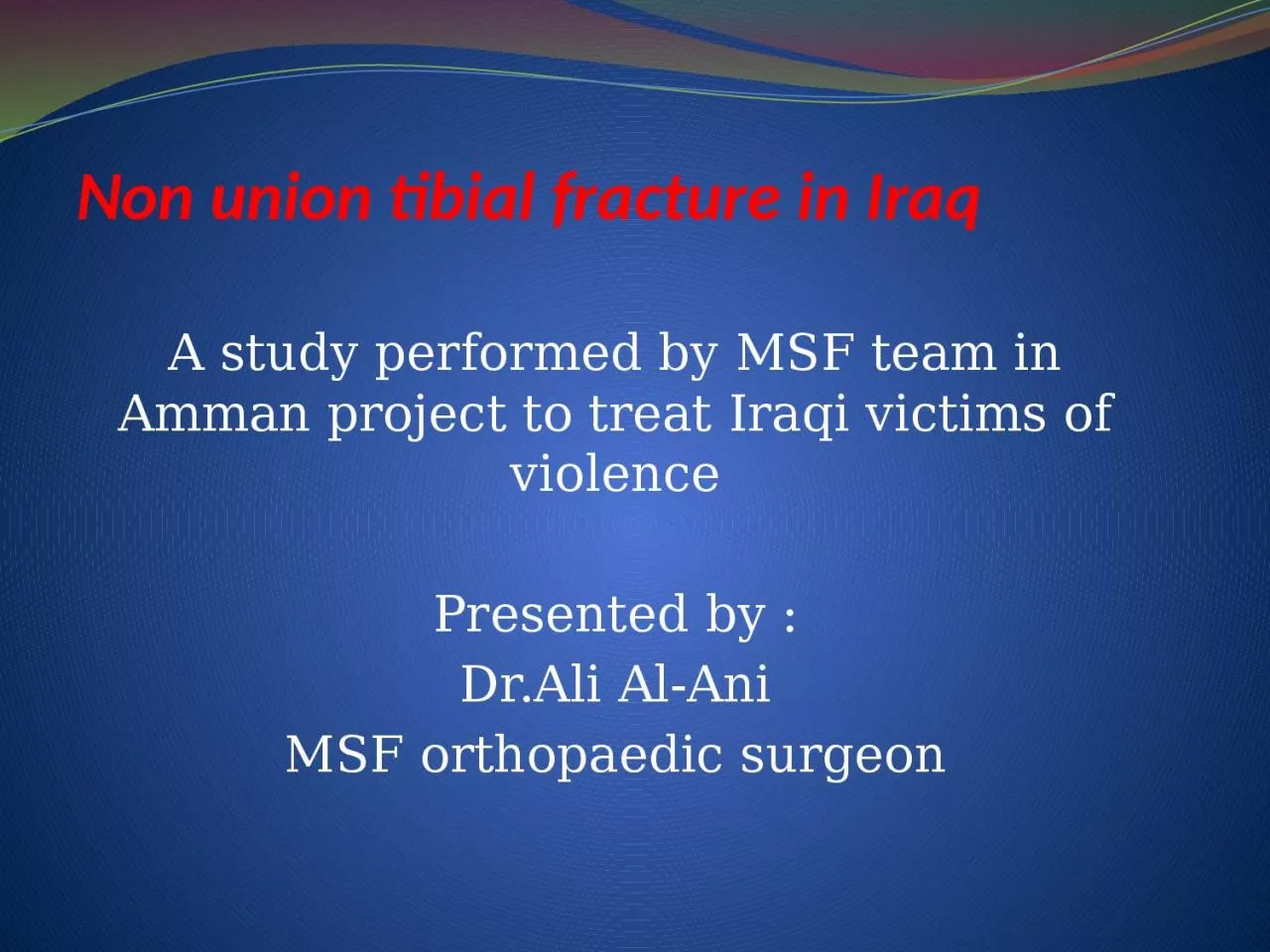

A study performed by MSF team in Amman project to treat Iraqi victims of violence Presented by DrAli Al Ani MSF orthopaedic surgeon Introduction Since the start of conflict in Iraq 2003 surgical team have been confronted with high number of war related injuries in civilians man ID: 1044503
Download Presentation The PPT/PDF document "Non union tibial fracture in Iraq" is the property of its rightful owner. Permission is granted to download and print the materials on this web site for personal, non-commercial use only, and to display it on your personal computer provided you do not modify the materials and that you retain all copyright notices contained in the materials. By downloading content from our website, you accept the terms of this agreement.
1. Non union tibial fracture in Iraq A study performed by MSF team in Amman project to treat Iraqi victims of violencePresented by :Dr.Ali Al-AniMSF orthopaedic surgeon
2. Introduction :Since the start of conflict in Iraq 2003 , surgical team have been confronted with high number of war related injuries in civilians, many of these require reconstructive surgery.
3. In 2006 MSF started a surgical programme for Iraqi civilians.Here we describe the surgical treatment for war related trauma in 62 patients from Iraq with tibial nonunion ( mostly infected) between August 2006 till December 2008.
4. Specialties: Maxillofascial , Orthopedic and plastic .Patients were selected by doctors network in Iraq.All patients had nonunion caused by war related compound diaphysial fracture.MSF protocol for reconstruction of tibial nonunion was a two stage approach:Fixation after debridement which ranges from Ex.Fix(uniplanner) , internal or POP.Patients with positive deep bone cultures were classified as infected injuries.
5. The clinical outcomes were assessed after patients discharged to Iraq included: recurrence of infection.Bone union.Functional outcome ( short musculoskeletal functional assessment) SFMA.All calculations were performed using Epi-Info version 3.5.1 (CDC, Atlanta).
6. 47% car explosion.41% bullet6% roadside bombing6% mortar bombs45% of the patients had infection at admission.Median age was 31 years, range 5-63.24/45(53%) had draining wounds.
7. All patients were treated primarily in Iraq.9 patients required amputation.The bacteriological data were complete for 37 patients(82%); 30% single bacterium, 70% more than one.An average of four operations were performed / patient.Bone graft was used in 27 cases( non vascularized iliac crest)
8. six patients , we used the method of tibialization of fibula.23% of surgeries included the plastic surgeon.Mean length of stay in Amman was longer for infected than non infected ( 166 vs 69 days).Early surgical complications: 15 :soft tissue margianl necrosis dehiscence hematoma 4: bone recur. Infec. Excis. malalign. readjust.
9. No deaths, only 3 allergic reactions.Late surgical complications,Mean follow up after discharge to Iraq was 730 days.9/62 are lost contact.53/62 (85%) were followed.
10. Recurrence of infection 5%Bone union 86% in noninfected and 83% in infected.SFMA 27.1 dysfunctional index and for bothersome index was 29.8 no significant difference between reconstruction in non infected and infected groups and amputation groups.
11. Discussion ; patients in our study were mainly young men.There were few publications focusing on tibial nonunion after civilian war injuries.Previous studies dealt with fresh cases that’s why our study is unique.We found 73% of tibial nonunion arrived from Iraq were infected.
12. about 15% of infection were occult.In 70% of patients more than one bacteria caused the infection which might be a result of severe war related injury, delayed presentation or inadequate facilities.5% had recurrent infection after more than one year.Two staged surgery has proved to good approach.There was neither a single type of injury or approach for treatment.
13. Psychologist were of great help in preparing the patients for amputation.Follow up outcomes are depending on: - infection recurrence. - bone union. - functional ability.
14. Following the general principals of two staged surgeries with a multidisciplinary surgical team, trustworthy lab.results and proper antibiotic management , patient populations surgically treated in Amman benefit from similar outcomes to those receiving treatment in better resourced contexts.
15. A victim of expolsion was presented after 69 day after injury with signs of deep infection , the primary fixation was done in Iraq.
16. Peroperative picture showing sequestrae at the site of injury which were excised and samples were sent to the lab for culture.
17.
18. 44 years old man, presented to our project in Amman with nonunion of the tibia and hidden deep infection after 678 days from injury. The fracture was fixed in Iraq by external fixation . with bad soft tissue cover. Cross leg flap was done by plastic surgeon with complete surgical excision and bone debridement with fixation of fracture by external fixator. After separation of the flap and complete infection treatment the external fixation was removed and then tibialization of the fibula done with additional bone graft
19. About one year after tibialization of fibula full union was obtained and the patient started to use stick to help in walking
20. Appearance of the leg after healing from infection and provision of cross leg flap without discharging sinus.
21. Thank you very muchFor your attention